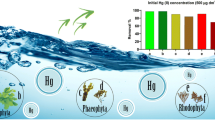Abstract
Macroalgae have received much attention for heavy metal removal in treatment of domestic wastewater. In this report, the uptake capacity of a common freshwater green alga, Cladophora fracta, for heavy metal ions (copper, zinc, cadmium, and mercury) was evaluated. The equilibrium adsorption capacities were 2.388 mg Cu2+, 1.623 mg Zn2+, 0.240 mg Cd2+, and 0.228 mg Hg2+ per gram of living algae at 18°C and pH 5.0. The removal efficiency for Cu2+, Zn2+, Cd2+, and Hg2+ were 99, 85, 97, and 98%, respectively. Greater removal efficiency was achieved when the concentrations of metal ions were at very low level. The results indicated that living algae are suitable for removal and recovery of heavy metal ions from aqueous solutions and can be a potential tool to treat industrial wastewater.


Similar content being viewed by others
References
Adhiya J, Cai X, Sayre RT, Traina SJ (2002) Binding of aqueous cadmium by the lyophilized biomass of Chlamydomonas reinhardtti. Colloids Surf A: Physicochem Eng Aspects 210:1–11
Andrade AD, Rollemberg MCE, Nobrega JA (2005) Proton and metal binding capacity of the green freshwater alga Chaetophora elegans. Process Biochem 40:1931–1936
Chojnacka K, Chojnacki A, Górecka H (2005) Biosorption of Cr3+, Cd2+ and Cu2+ ions by blue-green algae Spirulina sp. Kinetics, equilibrium and the mechanism of the process. Chemosphere 59:75–84
Davis TA, Volesky B, Mucci A (2003) A review of the biochemistry of heavy metal biosorption by brown algae. Water Res 37:4311–4330
Deng LP, Su YY, Su H, Wang XT, Zhu XB (2006) Biosorption of copper (II) and lead (II) from aqueous solutions by nonliving green algae Cladophora fascicularis: equilibrium, kinetics and environmental effects. Adsorption 12:267–277
Deng LP, Zhu XB, Su YY, Su H, Wang XT (2008) Biosorption and desorption of Cd2+ from wastewater by dehydrated shreds of Cladophora fascicularis. Chinese J Oceanol Limnol 26(1):45–49
Eccles H (1999) Treatment of metal-contaminated wastes: why select a biological process? Tibtech 17:462–465
General Administration of Quality Supervision, Inspection and Quarantine of the People’s Republic of China (1996) GB 8978-1996 Integrated Wastewater Discharge Standard. Chinese Standard Press, Beijing
Kratochvil D, Volesky B (1998) Advances in biosorption of heavy metals. Trends Biotechnol 161:291–300
Langmuir I (1918) The adsorption of gases on plane surface of glass, mica and platinum. J Am Chem Soc 40:1361–1403
Li X, Hu HY, Gan K, Yang J (2010) Growth and nutrient removal properties of a freshwater microalga Scenedesmus sp. LX1 under different kinds of nitrogen sources. Ecol Eng 36:379–381
Lombardi AT, Vieira AVH, Sartori LA (2002) Mucilaginous capsule adsorption and intracellular uptake of copper by Kirchneriella aperta (Chlorococcales). J Phycol 38:332–337
Mehta SK, Gaur JP (2005) Use of algae for removing heavy metal ions from wastewater: progress and prospects. Crit Rev Biotechnol 25:113–152
Patrick K (2009) Top ten natural ways to remove heavy metals. Natural News. http://www.naturalnews.com/026885_natural_zeolite_heavy_metals.html. Accessed 20 August 2009
Pawlik-Skowronska B (2001) Phytochelatin production in freshwater algae Stigeoclonium in response to heavy metals contain in mining water, effects of some environmental factors. Aquat Toxicol 52:241–249
Raiz O, Argaman Y, Yannai S (2004) Mechanism of biosorption of different heavy metals by brown marine macroalgae. Biotechnol Bioeng 87:451–458
Shen HM, Feng J, Shi Y, Liu XL, Xie SL (2009) Phytoplankton and evaluation of water quality in the Taiyuan Section of Fenhe river. J Shanxi Univ (Nat Sci Ed) 32(2):75–78
Singh A, Mehta SK, Gaur JP (2007) Removal of heavy metals from aqueous solution by common freshwater filamentous algae. World J Microbiol Biotechnol 23:1115–1120
Travieso L, Cañizares RO, Borja R, Benítez F, Domínguez AR, Dupeyrón R, Valiente V (1999) Heavy metal removal by microalgae. Bull Environ Contam Toxicol 62:144–151
World Health Organization (2006) Guidelines for drinking water quality, vol 1, 3rd edn, Recommendations. WHO Press, Geneva
Yu Q, Matheickal JT, Yin P, Kaewsarn P (1999) Heavy metal uptake capacities of common marine macro algal biomass. Water Res 33:1534–1537
Acknowledgments
We thank Dr. JA Jiao (Vice President, Process Development, Hematech LLC, Sioux Falls, South Dakota, USA) for his critical reviews of the manuscript and editorial assistance with the English language. This work was supported by the foundation of Plateform Construction Project of Infrastructure for Science and Technology of Shanxi (2009091015).
Author information
Authors and Affiliations
Corresponding author
Rights and permissions
About this article
Cite this article
Ji, L., Xie, S., Feng, J. et al. Heavy metal uptake capacities by the common freshwater green alga Cladophora fracta . J Appl Phycol 24, 979–983 (2012). https://doi.org/10.1007/s10811-011-9721-0
Received:
Revised:
Accepted:
Published:
Issue Date:
DOI: https://doi.org/10.1007/s10811-011-9721-0




